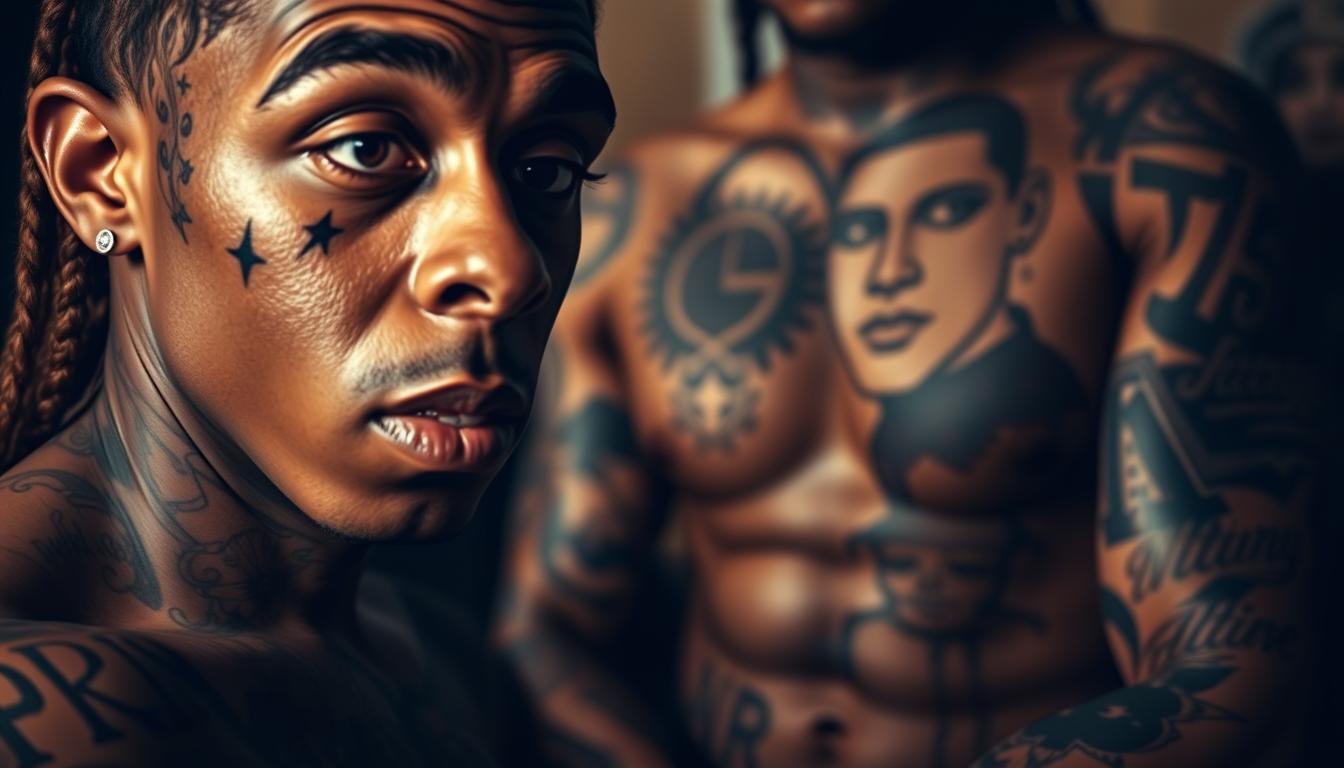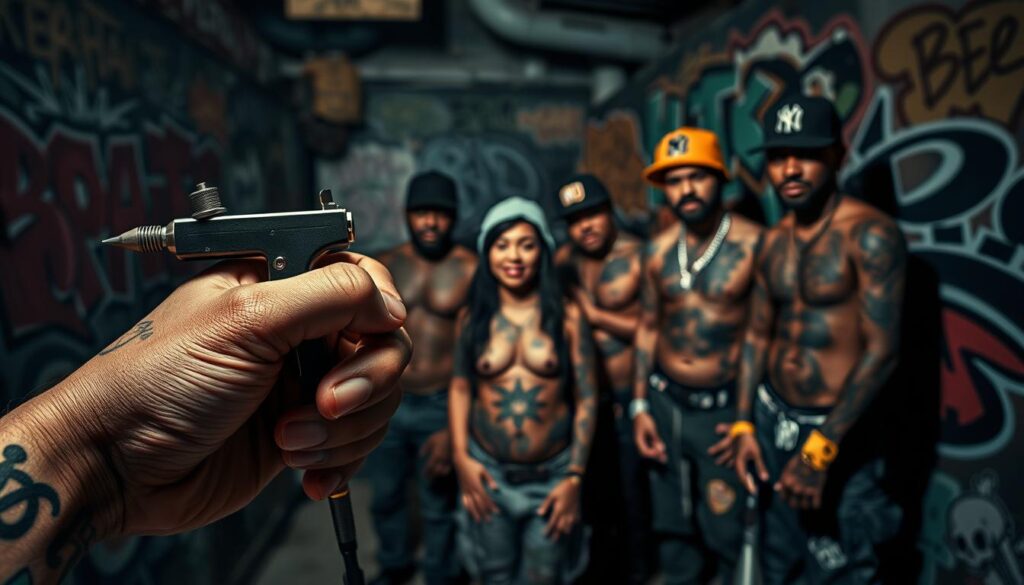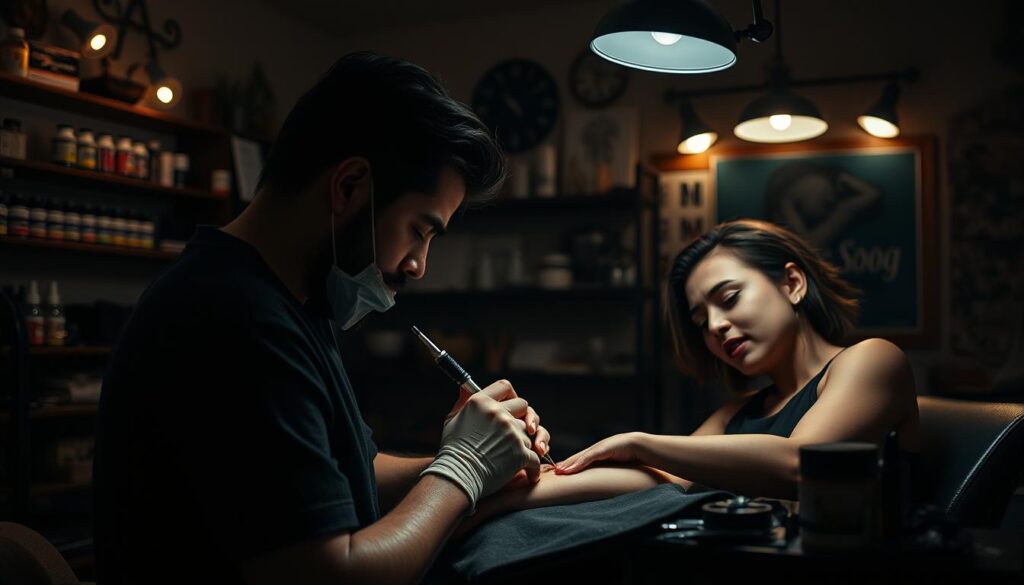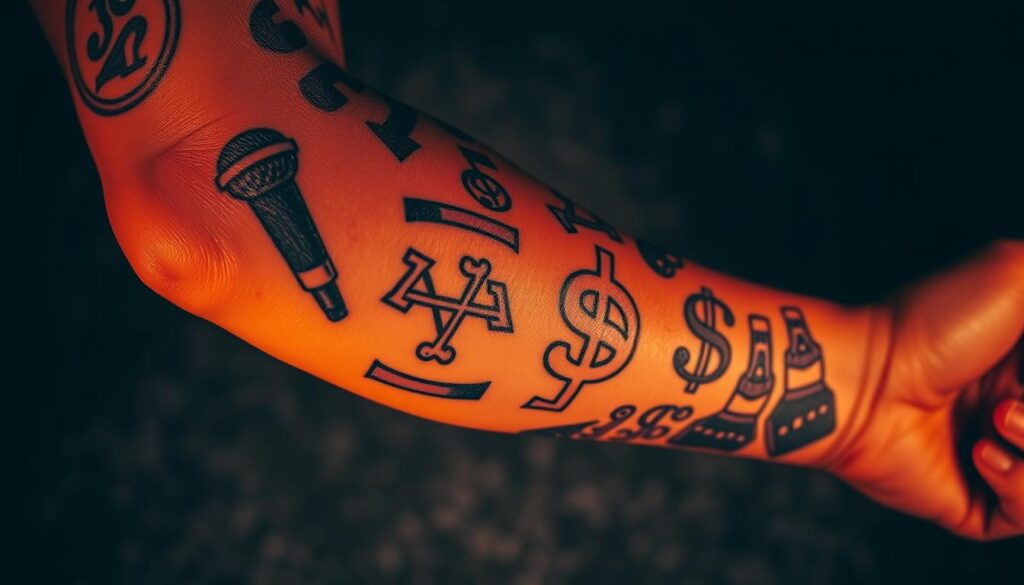
Imagine wearing your life story on your skin. For one of hip-hop’s biggest legends, body art isn’t just decoration—it’s a living diary of triumphs, struggles, and identity. This artist’s ink transforms his physique into a walking gallery, blending streetwise creativity with deeply personal meaning.
Born in New Orleans, his designs mirror the city’s resilience. From bold facial pieces that challenged music industry norms to subtle tributes to family, every mark carries weight. The rapper’s choices sparked conversations about self-expression in hip-hop, turning skin into a cultural conversation starter.
You’ll notice symbols like teardrops, wings, and religious icons across his canvas. These aren’t random—they map his journey from childhood hardships to global fame. Even the phrase “Fear God” inked near his eye reflects his spiritual outlook amidst fame’s chaos.
What makes this collection iconic? It’s raw authenticity. While some celebrities hide their past, his body art celebrates it, inspiring fans to embrace their own stories through ink. Whether you’re drawn to bold statements or subtle symbolism, there’s wisdom in how he merges art with identity.
Key Takeaways
- Body art serves as a visual autobiography for the artist
- Facial ink helped normalize bold tattoos in mainstream culture
- Symbols reflect personal growth and New Orleans roots
- Religious motifs reveal spiritual foundations
- Authenticity in design inspires fan self-expression
Overview of Lil Wayne’s Tattoo Culture and Impact

Skin isn’t just a canvas—it’s a chronicle of battles won. In hip-hop’s visual revolution, one artist’s ink became a blueprint for authenticity. His choices transformed how the rap world perceives body art, turning skin into a manifesto of personal freedom.
Breaking Barriers With Permanent Statements
When most artists avoided facial ink, he embraced it as a badge of defiance. Starting in his teenage years, what began as small symbols grew into a full-body mosaic. Collaborating with trusted artists for over seven years, he crafted a living timeline of his journey from New Orleans streets to global fame.
Ink as Identity Blueprint
Every design serves dual purposes: artistic flair meets raw autobiography. Stars map career milestones, while religious symbols anchor spiritual beliefs. Unlike trend-driven choices, his selections mirror life chapters—losses, triumphs, and unshakeable roots.
This approach sparked a movement. Fans worldwide now see body art as legitimate self-expression rather than rebellion. By merging streetwise aesthetics with profound meaning, he proved tattoos could be both deeply personal and culturally transformative.
Exploring lil wayne tattoos: Iconic Ink and Deep Symbolism
![]()
Your skin tells stories words can’t capture. For one rap legend, every mark serves as a roadmap through pain, triumph, and self-discovery. Let’s decode the hidden language behind his most talked-about designs.
Celestial Guides and Emotional Anchors
Nine stars blaze across the left cheekbone, acting as cosmic guardians for an artist navigating fame’s turbulence. Below the right eye, two teardrops freeze grief in ink—permanent tributes to loved ones lost too soon.
Three tiny dots near the left eye whisper a life motto: “Laugh, Think, Cry.” This trio captures his belief in embracing every emotion without filter. Above the brow, “I AM MUSIC” declares his soul’s true identity.
Eyelids bearing “Fear God” turn every blink into a prayer. These aren’t just decorations—they’re spiritual armor against life’s chaos.
Identity Etched in Letters and Lines
A single “C” bridges the eyes, honoring both his mother Cita and the Carter legacy. Behind the ear, “Tune” preserves his grandmother’s voice forever—a childhood nickname turned memorial.
Neck ink reveals layers of loyalty. The Young Money logo sits alongside “Soo Woo,” blending career pride with street roots. “Misunderstood” carved into the cheek shouts silent frustration at public judgment.
Even playful choices carry weight. A hidden smiley face inside the lip winks at life’s absurdity, while “999” behind the ear flips darkness into hope. Every symbol threads personal history with cultural resonance.
Inside the Tattoo Studio: Behind-the-Scenes Insights

Midnight oil burns bright in the world of ink. For seven years, one artist’s chair became a confessional booth where music met needlework. Dow Hokoana, the creative force behind 300+ designs, reveals how trust and endurance shaped this living art project.
Stories From Personal Sessions
Sessions stretched from midnight till dawn, blending focus with laughter. Hokoana recalls the rapper’s work ethic: “He’d sit for hours without flinching, even in sensitive areas.” Their 3.5-year body suit project broke barriers—literally. A vibrant checkerboard on his backside proved color thrives on darker skin tones.
Artist Perspectives on Collaboration
Spontaneity fueled iconic pieces. A lightning bolt cheek design sparked from Hokoana’s daughter’s backpack. Vegas showgirls wrapping his hip required precision. “He’d point at random objects,” she laughs, “and we’d turn it into art.”
Between pranks and bowling nights, professionalism ruled. Tabasco sauce antics balanced with deep respect for the craft. For Hokoana, it wasn’t just a job—it was rewriting what’s possible on human skin.
Creative Tattoo Ideas Inspired by Lil Wayne

Stories unfold where skin meets artistry. The rapper’s ink choices offer endless inspiration for turning personal journeys into visual statements. Below, discover fresh approaches to designing body art that resonates with your unique path.
Design Concepts for Your Next Ink
Transform stars into storytelling tools. Cluster them along collarbones as career milestones or scatter single symbols behind ears for subtle nods to loved ones. Text-based designs gain power through placement—consider wrist script for daily reminders or ribcage phrases for private mantras.
Family tributes shine through initials reimagined as ornate letters. A grandmother’s nickname could wrap around your forearm like jewelry. For hometown pride, blend skyline silhouettes with cultural motifs beneath sleeves.
Mixing Tradition with Modern Rap Culture
Blend old-school flash art with hip-hop edge. Anchor bold lettering with classic rose designs, or frame portrait tattoos with graffiti-style borders. This fusion creates pieces that honor tattoo history while reflecting urban creativity.
| Design Element | Traditional Approach | Modern Twist |
|---|---|---|
| Stars | Nautical shoulder pieces | Facial constellations |
| Text | Script banners | Micro-lettering near eyes |
| Symbols | Anchor wrist tattoos | Abstract finger dots |
Tips for Customizing Tattoos That Reflect Your Story
Map designs to body contours for natural flow. Darker skin tones pop with vibrant oranges and deep greens, while fair complexions handle delicate grayscale shading. Always consult artists about aging—certain placements fade faster than others.
Build collections gradually. Start with test-run temporary tattoos in target areas. Document ideas in a sketchbook, letting patterns emerge organically over months. “Your skin’s a lifelong canvas,” says artist Mia Parker. “Treat each piece like a chapter, not the whole book.”
Conclusion
Your skin could be a map of your journey, just like the rapper’s iconic designs. Through his ink, you’ve discovered how body art transforms into living history—each star, name, and symbol marking chapters of resilience and reinvention.
From the New Orleans streets to spiritual symbols near the eye, every piece carries weight. The tear drop below the lid isn’t just ink—it’s frozen emotion. Phrases like “Fear God” turn glances into moments of reflection, while hidden initials whisper family bonds.
What started as rebellion became a blueprint for self-expression. Face designs once shocked the industry—now they inspire millions. Over years, his collection taught people that skin can honor roots while embracing growth.
Your next tattoo might not cover your entire side or ear, but it can hold similar power. Whether choosing bold statements or subtle nods, remember: true meaning comes from what you choose to immortalize. Let your art tell your story—one line at a time.
